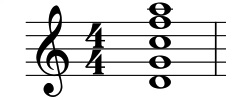Jazz consists of two parts:
- Jazz Chords (Harmony); and
- Improvisation (Melody).
To facilitate my teaching, I have further subdivided the above two facets of Jazz into Theory and Practice components. We have already discussed the Theory aspect (Jazz Chords and Jazz Scales) so it's time to discuss how to apply the theory in Practice (with Jazz Chord Voicings and Jazz Improvisation).
| Theory | Practice | |
| Harmony | Jazz Chords | Jazz Chord Voicings |
| Melody | Jazz Scales | Jazz Improvisation |
We have already discussed Jazz Chords in a previous Module. In that Module we learned that chords are built up in thirds. For example, you could play a CMaj7 chord as C E G B with each note a third above the previous (called 'tertian harmony') and all the notes within the range of an octave (called 'close harmony' or 'block chords'). While this is nice and simple, it unfortunately is not enough.
Playing chords in tertian and close harmony is today considered very simplistic and naive. Instead we have to employ more sophisticated and complex chord voicings to create a jazzier sounding chord.
A chord voicing is just a way of altering the order of and intervals between the notes in a chord. So instead of playing CMaj7 as a block chord (C E G B) we could reorder the notes and play C B E G - which spans two octaves (called 'open harmony'). This is considered more sophisticated and 'jazzy'.
While there is a place for block chords in Jazz (see the Locked Hands lesson), by and large Jazz uses more elaborate voicing techniques such as:
- Quartal Harmony;
- Upper Structures;
- So What Chords; and
- Rootless Chords.
This series of lessons will cover some widely used Jazz Chord Voicings, then discuss how to combine them, and finally give some general chord voicing rules so you can create your own voicings. And after learning how to voice chords, in the next Module we learn some common Jazz Chord Progressions where you can apply your newly acquired voicings.
How to Practice Chord Voicings
The best way to practice chord voicings (and Jazz in general) is by playing actual songs. Try apply each chord voicing you learn in each of these lessons to a particular Jazz Standard you enjoy. Plus it's more fun than just playing scales up and down all day!
